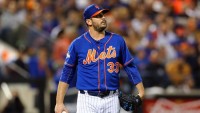Hot Stove
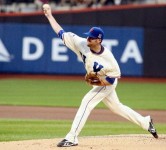
Almost. That’s the one word I think of when I think of Bobby Parnell‘s Mets career. He almost figured it out.
The Mets organization always thought of him as a reliever, but in 2009, when the team no longer had nothing to play for other than finding out who will be a part of the future, they let Parnell start some games. In his first home start, he pitched six shutout innings against the Giants. It was downhill from there. It didn’t mean Parnell was a bad pitcher, it just meant he was reliever.
It didn’t change the fact that the Mets had high hopes for him. They saw him as a future closer. He had the stuff for it. He put together some good seasons. Then he had the break he needed in his career. In 2011, he was mentored by Jason Isringhausen. The next two years would be the best years of his career. In 2013, he would fulfill what the Mets saw as his destiny. He became their closer.
It would be the best year of his career. He recorded 22 saves. He had a 2.16 ERA with a 2.33 FIP, a 166 ERA+, and a 1.000 WHIP. He was a reason for hope for 2014 and beyond. Well, almost. He had elbow problems going into the 2014 season. After one poor appearance, he had to be shut down and have Tommy John surgery.
He tried to come back in 2015, but he was ineffective. Up until his surgery, Parnell had a 96 MPH fastball with an 87 MPH slider, 84 MPH curve, and a 89 MPH split. Upon his return, his repertoire was a tick slower with a 94 MPH fastball, 82 MPH curve, and a 89 MPH split. His WHIP jumped to 1.958. His ERA+ was 59. Whereas Matt Harvey was given a year and a half to rehab, Parnell rehabbed for barely over a year.
He apparently needed more time. Once again, he was almost ready.
He’s a former Met now having signed with the Detriot Tigers on a minor league deal. He’s on a team that seemingly needs bullpen help each and every year. Hopefully for him, he’s ready. I hope he’s past being almost there.
He was a good Met. He had periods of effectiveness. It almost worked out well in New York.
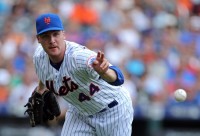
Normally, when a player leaves the Mets, I like to take stock of all the good things they did with the Mets. With Eric O’Flaherty it’s near impossible.
When the Mets acquired him, I thought he was the missing piece to the Mets bullpen. He was going to be the LOOGY the Mets needed. Instead, O’Flaherty was just terrible. He had a 13.50 ERA and a 2.654 WHIP. Honestly, I’m not even sure he was that good. To put it in perspective, his ERA+ was 29. TWENTY-NINE! While I could say that there are no words to describe how poorly he pitched with the Mets, I think saying 29 describes it perfectly.
To be fair, there was one good thing that came from the O’Flaherty trade. The corresponding move was the Mets designating Alex Torres and all his hats for assignment. For that, Mets fans do owe him a little bit of gratitude.
Now, he’s off to Pittsburgh on a minor league deal. I’m sure now that he’s completed his post-Tommy John season and his being under the tutelage of Ray Searage, O’Flaherty will return to the effective LOOGY he once was. I’m positive hell revert back to the guy that has a 1.69 career ERA against the Mets.
In any event, O’Flaherty is a Pittsburgh Pirate ending his reign with the New York Mets. I think I speak for everyone when I say that’s best for everyone.

We are all guilty at times of becoming too focused on statistics when it comes to determining a player’s worth. Sometimes we overlook the value of being able to take the ball whatever the situation. Ultimately, that was Carlos Torres‘ greatest attribute.
Over the past three years, Terry Collins stretched that rubber arm of his to a breaking point. Torres served as a spot starter, long man, and set-up guy in his three years with the Mets. In his time with the Mets, he averaged over 1.1 innings per appearance. Torres’ rubber arm allowed Collins to rest the other arms in the Mets bullpen. There is immense value in a pitcher that can constantly take the ball in a variety of spots.
However, saying Torres’ value was taking the ball whenever needed is underselling him. Torres was an effective pitcher with the Mets. Torres had a 3.59 ERA, a 1.253 WHIP, and an 8.2 K/9 in his three years in Flushing. He was a good pitcher. Unfortunately, after all the time and hard work he put in with the Mets, Torres was hampered by a hamstring injury which prevented him from pitching in the postseason.
However, that’s not to say he didn’t have an impact on the 2015 season. He started and finished the most amazing defensive play of the season:
We also discovered he might’ve been the fastest Met on the team. Finally, he gave up his number 52 for Yoenis Cespedes. I expected nothing less from someone who was a team first guy.
With the Mets signing Antonio Bastardo, there wasn’t any room for him left on this Mets team. It’s a cruel twist of fate we see all too often in sports. A guy gives everything he has to help a losing team, and when things begin to turn around, he is sent packing. It’s unfortunate, but it’s the way things work. Sure, Torres deserved better, but that still doesn’t mean there was room for him on the 25 man roster.
With that said, it shouldn’t come as no surprise that Torres didn’t return to the Mets. Not even on a minor league deal. Instead, Torres signed a minor league deal with the Braves. He should have no problem making their Opening Day roster as Torres can fill any role he teams needs.
Teams always need a player like Torres, and I’m sure at varying points of the season, so will the Mets. He was a player who brought real value to the team. It certainly leaves a hole in the organization not having him and his rubber arm around anymore. He was a good Met, and he will be missed.
Thank you Carlos Torres.
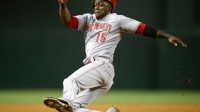
Yesterday, the Mets signed Roger Bernadina to a minor league deal. Anytime the Mets sign a player on a minor league deal, I think it’s a great low risk high reward move.With that said, I’m curious why the Mets signed Bernadina.
Bernadina is a 31 year old outfielder that was originally signed by the Montreal Expos. He played three full seasons with the successor Nationals before being released. Bernadina bounced around a bit since, and he spent all of 2015 in the minor leagues. He’s a career .236/.307/.354 hitter. He’s played all three outfield positions in his career reasonably well. Considering the Brandon Nimmo injury and the Darrell Ceciliani trade, this was a good depth move. Or was it?
His current deal with the Mets he has a June 15th opt out clause. That’s the same day the Mets can trade Alejandro De Aza without any restrictions. This begs the question whether Bernadina was signed as minor league depth, or whether he was signed so the Mets could trade De Aza? Is Berndina slated to be the fifth outfielder or is he really just depth to protect against injury?
Time will tell. In either scenario, this was a solid organizational depth move by the Mets.
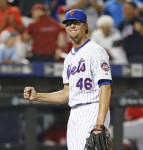
Last season, the Mets trading for Tyler Clippard was the first sign that the Mets were all-in on the 2015 season. The Mets gave up a very promising prospect in Casey Meisner for three months of a middle reliever.
When Clippard came to the Mets, he immediately locked down the eighth inning. When the division was still in doubt, from July 28th to September 16th, he pitched 26.1 innings in 26 appearances with a 2.73 ERA and a 1.03 WHIP. He limited batter to a .182/.257/.364 batting line. He combined with Jeurys Familia to make Mets games seven inning games. Combined with the Mets starting pitching, you have a 20-8 August and the Mets putting away the Nationals and the NL East.
With that, Clippard completed his goal of “chasing down [his] old teammates there in Washington.” He wanted bragging rights over his old teammates, and he got them.
Unfortunately, Clippard suffered a back injury. His production fell off significantly. He wasn’t the shut down reliever he was when he first joined the Mets. That Clippard was missed in the World Series. He was the loser in Game Four, which was probably the turning point in that series. After that the Mets apparently felt he didn’t deserve the two-year deal they gave Antonio Bastardo.
Personally, I thought with the offseason, Clippard would’ve had time to heal and become that eighth inning option again. I’m still surprised the Mets thought he was worth a potential ace, saw him perform well, and now think he’s not worth a two year deal. Well now, the Mets loss is the Diamondbacks gain. Now, Clippard is an ex-Met after him doing everything he could do to help the team win the NL East. He leaves with those bragging rights.
The Mets now have bragging rights over everyone in the National League. With that, we all owe him a small debt of gratitude. When he comes out of that bullpen door come this August, he deserves to be cheered. He deserves that much.
Thank you Tyler Clippard.
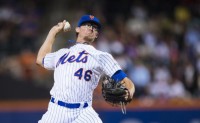
Last year, when the Mets had delusions of grandeur that the worst offense in Mets history could go to the World Series, the Mets traded for Tyler Clippard. In exchange for two months of Clippard, the Mets have up Casey Meisner, who was a well regarded prospect.
Initially, Clippard delivered for the Mets. Up until his back injury, Clippard pitched very well. From July 28th to September 16th, Clippard made 26 appearances pitching 26.1 innings. In those innings, he had a 2.73 ERA with a 1.03 WHIP limiting hitters to a .182/.257/.364 batting line. In short, he combined with Jeurys Familia to make it a seven inning game, which is all the more frightening for opponents when you consider the Mets pitching staff.
Apparently, despite the Mets adding a couple of relievers, they are still interested in Clippard, but only on a one year deal. I don’t get it. Yes, Clippard had the worst year of his career last year. However, in the midst of that year, the Mets traded away a promising young starter. Now, the Mets don’t have to give up any young players. Instead, they only have to give Clippard an extra year. They’re balking at that second year. It doesn’t make sense.
Keep in mind, the Mets just handed Antonio Bastardo a two year $12 million contract. Bastardo turns 31 in September. For his career, Bastardo has a 3.58 ERA, 109 ERA+, 1.198 WHIP, and an 11.0 K/9. Last year, Bastardo pitched 57.1 innings in 66 appearances. He had a 2.98 ERA, 129 ERA+, 1.134 WHIP, and a 10.0 K/9.
Clippard turns 31 in two weeks. For his career, he has a 2.88 ERA, 138 ERA+, 1.089 WHIP, and a 9.8 K/9. Last year, Clippard pitched 71.0 innings in 69 appearances. He had a 2.92 ERA, 134 ERA+, 1.127 WHIP, and an 8.1 K/9.
Looking at the numbers, Clippard is a better reliever than Bastardo. Furthermore, Clippard established he could not only pitch well in New York, but he could also pitch well as the main set-up guy in a pennant race in New York. With that said, the Mets should offer Clippard the extra year, like they did with Bastardo, and get the deal done.

While everyone is trying to decipher the outfield configuration after the Yoenis Cespedes signing, there is the issue of how the signing puts added importance on Wilmer Flores‘ ability to be a backup infielder.
Third Base
Make no mistake. The Mets need Flores to be able to handle the role and handle it well. For starters, we do not know David Wright‘s ability to withstand a full 162 game schedule. Last year, Wright had difficulty playing three days in a row. It impacted his offense and defense. With a full offseason to continue the extra work needed due to his spinal stenosis, that could change for Wright. It also may be a new reality.
Flores has to be ready, willing, and able to play third at a monent’s notice. In his major league career, Flores has only played 209 innings at third base. During that limited time, he did show the ability to handle the position. The problem is he has to work on his third base defense while addressing his second base defense.
Second Base
When the Mets acquired Neil Walker to replace Daniel Murphy, the Mets obtained a switch-hitting second baseman who has hit .272/.338/.427 over the course of his career. That’s with him coming off the worst year of his career last year when he hit .269/.328/.427 with 16 homers and 71 RBI. One of Walker’s issues last year was left-handed pitching. Walker hit a dreadful .237/.284/.290 in 62 games against lefties. For his career, Walker has hit an underwhelming .260/.317/.338 against lefties in his career. Effectively, Walker is a platoon player.
Ideally, that platoon parter would be Flores. However, Flores has to be able to hit lefties himself. Last year, Flores did that with aplomb. In 57 games, Flores hit .310/.355/.600 with 7 of his 16 homers against lefties last year. However, for his career, Flores has only hit .230/.288/.403 against lefties in his brief major league career. Overall, for the Walker trade to work Flores needs to be the 2015 version of himself against lefties as opposed to what he’s done against them in his entire career.
First Base
First base is where it starts to get dicey for Flores. With the Cespedes signing, Lucas Duda became the only player on the roster with any major league experience at first base. This forces Flores to learn a new position in addition to keeping prepared for his other backup roles.
How much Flores is needed will depend on Duda. Last year, Duda hit a respectable .285/.333/.545 with seven homers and 21 RBI in 82 games. However, much of that was fueled by an extraordinarily high BABIP of .385. For his career, Duda has hit .229/.301/.369 with a .321 BABIP. In short, Duda is due for a regression against lefties. It will be Flores’ job to cushion the fall back to earth while hoping his numbers against lefties doesn’t regress either.
Shortstop
The Mets signed Asdrubal Cabrera to be the new everyday shortstop. A role that used to belong to Flores. Cabrera’s backup to open the season should be Ruben Tejada, who actually wrestled the shortstop job away from Flores last year.
Here’s the issue. The one spot Flores isn’t backing up is the one spot he’s most needed. Last year, Cabrera had a -6.0 UZR and a -7 DRS at shortstop. For his career, he has a -55.5 UZR and a -29 DRS at short. Tejada had a -5.6 UZR and a -15 DRS at short last year. For his career, he has a -1.5 UZR and a -20 DRS there. Flores had a -2.5 UZR and a -10 DRS at short last year with a 1.5 UZR and a -13 DRS for his career.
So defensively, Flores is the best shortstop option. However, the Mets are going with Cabrera in the hopes that his .328/.372/.544 second half will carry forward because otherwise the Mets signed a shortstop who has hit .249/.307/.405 in the three years since his last All Star appearance. Ironically, the position Flores is best suited to on this team is not a position he is tops on the depth chart going into next season.
Pinch Hitter
Since this is the National League, Flores will need to be ready to pinch hit for the pitcher or for a left handed when a LOOGY enters the game. In his career, Flores has only had 13 plate appearances where he hit .250/.308/.333. These are around his career numbers of .253/.287/.386. Accordingly, Flores can reasonably be expected to replicate his career batting line as a pinch hitter next year. Whether that’s good or not is a whole other matter.
Conclusion
Surprisingly, much of what the Mets want to do lies on Flores’ shoulders. He had to platoon at second. He had to hit against tough left-handles while playing first. He has to be available at a moment’s notice to play third. He’s available to play each and every one of these roles because the Mets are placing their top shortstop option, Flores, on the bench.
Flores is still only 24 years old. He works hard, and he will do everything he can do to improve and help the team. He’s going to need to be proficient in three to four infield positions because the Mets really need his help.
Editor’s Note: this article first appeared on metsmerized.com

As we have seen throughout their history, the media has had a profound impact on the Mets. We first saw it with Dick Young’s columns leading to Tom Seaver demanding a trade. There were the days of Mike and the Mad Dog bringing Mike Piazza to the Mets. Dick Young has since passed, Mad Dog Chris Russo is on Sirius XM, and Mike Francesca has announced he’s leaving WFAN in 2017.
It appears the torch has already been passed to Mike Vaccaro. If you’re asking who Mike Vaccaro is right now, newspapers are in bigger trouble than advertised. With that said, Mike Vaccaro is the preeminent sports columnist in New York. A July column of his secured his place amongst the greats.
Back in July 2015, Mets fans were subjected to Eric Campbell and John Mayberry, Jr. hitting the in the middle of the lineup. Mets fans were clamoring for a trade. Sandy Alderson mocked Mets fans referring to New York as “Panic City.” Mike Vaccaro called it what it really was, “Malpractice.”
He kept the heat on up until the trade deadline. He questioned if the front office was a fraud. He called the lineup an indictment of Sandy Alderson. He called the Mets willfully ignorant. He said the Mets were not committed to making the team better. He kept the heat on the Mets. He wasn’t saying anything different than every Mets fan was at the time. It’s one thing for Mets fans to hoot and holler on Twitter. It’s another thing for a respected columnist to say it.
The Mets began a relative flurry of trades before the non-waiver trade deadline acquiring Tyler Clippard, Kelly Johnson, Juan Uribe, and Yoenis Cespedes. Whether you thought the trades were good, bad, or ugly, this series of trades changed the narrative about the Mets. I’m sure a number of factors went into those decisions, but I’ll never discount the public pressure. I’ll always appreciate that Mike Vaccaro for being the lead voice. Anytime you have a cause, no matter how relatively insignificant, it’s always beneficial to have a well respected voice leading the way.
By the way, when you were upset with the offseason, so was Mike Vaccaro. He called out the Wilpons for being cheap. Again, he said exactly what you and I were thinking. Again, the public pressure was ratcheted up. Then it happened. The Mets re-signed Yoenis Cespedes. They expanded payroll to make it commensurate with revenues and the market in which they play. In the end, that’s all that Mets fans were asking of ownership.
We can all parse through who gets credit for all of this, and I’m sure there’s enough credit to spread around to everyone. However, I don’t think anything resonated quite like the Malpractice column. At least to me, it was a seminal moment.
A large part of Dick Young’s legacy was his columns which caused Seaver to demand a trade. With it came some awful baseball and an empty Shea Stadium. Part of Mike Francesca’s legacy was the Mike Piazza trade, and by extension, Piazza entering the Hall of Fame as a Met. Right now, part of Mike Vaccaro’s legacy is Yoenis Cespedes being a Met. The rest of that story is yet to be written. When it is written by Mike Vaccaro, it will be a must read.
In any event, Yoenis Cespedes is still a Met, and for that, I say, “Thank you Mike Vaccaro.”
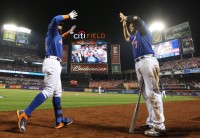
It’s incredible to think Yoenis Cespedes is back with the Mets. Everyone associated with the Mets should be thrilled. Cespedes’ presence on the Mets makes them a better team than the one they had. The question is how much better.
Well, first let’s get some things out of the way. Cespedes will not be as good as he was when he first came to the Mets. He was insanely hot. He hit 17 homers in a less than two months. That’s roughly a 50 homerun pace. He has power, but he’s never shown that much power. Cespedes also isn’t the .150 hitter we saw struggle in the World Series. As with everything else in life, the truth is somewhere inbetween.
Cespedes is a career .271/.319/.486 hitter. In an average season, he hits 30 homers and 103 RBI. His OPS+ is 122. His wRC+ is 121. All of this is to say that while he’s not the hitter he was initially with the Mets, he’s still a very effective slugger. The various projections seem to think he’ll hit a little worse than his career averages next year:
- Marcel: .265/.309/.480 with 26 homers and 88 RBI
- Steamer: .266/.312/.463 with 26 homers and 72 RBI
- ZiPS: .270/.312/.498 with 30 homers and 98 RBI
So, the projection systems, for what they’re worth, see Cespedes’ production dipping slightly in 2016. Part of that could be his first post-30 year old season. Part could be his .236/.302/.491 batting line Cespedes has had at Citi Field. I believe all Mets fans believe the reason should be that these projections are plain wrong and Cespedes will be more like he was in August and September.
The thing is Cespedes is going to have to be that 30+ homerun guy for the Mets. He needs to be that guy not only because the lineup needs another power threat, but also the fact that he needs to makeup for the fact that he’s a poor centerfielder. Remember, he has a career -12.6 UZR and -17 DRS in centerfield. Those are ugly numbers. Numbers which should be somewhat abated by Juan Lagares coming in late as a defensive replacement thereby shifting Cespedes to his natural LF.
So overall, it seems Cespedes will be poor defensively, and he will hit for power. More importantly, with Cespedes the Mets should be projected to win the NL East. Once the Mets get to that point, they have the pitching to win the World Series.
I’m projecting a very fun 2016 ahead.
